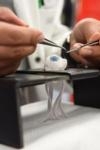Mobile Simulation Center Transforms Training With The Latest In Technology And Surgical Knowledge
The Orbis Flying Eye Hospital—the world's only U.S.-accredited teaching hospital on board an MD-10 aircraft—has returned to Trujillo, Peru for the sixth time to deliver a three-week ophthalmic training from April 2 - 20. For the first time, Orbis will dedicate the first week to training medical professionals from the Instituto Regional de Oftalmología (IRO) through simulation technology.

Thanks to the generous support of UTC Aerospace Systems, the new simulation center and training program combines the latest in simulation technology, virtual reality, and scientific, surgical and medical knowledge. The curricula that has been developed focuses on holistic simulation training for every member of the ophthalmology team including doctors, nurses and anesthesiologists.
"As a company of Ideas Born to Fly, UTC Aerospace Systems can't imagine anything more important than equipping the world's only flying eye hospital with the latest in simulation technology and bringing it to people in need around the world," said Stacey MacNeil, Vice President of Communications, UTC Aerospace Systems. "That's what started this relationship between us and Orbis—our shared vision to move the world forward to fight avoidable blindness."
The program will add a new dimension to training and increase the number of opportunities offered to local doctors, expanding to first- and second-year residents. It allows local ophthalmic teams to learn and practice complex surgical skills in a controlled environment before operating on patients, and breaks down a complex surgery into smaller parts allowing local doctors to focus on a certain skill—something you can't do with a human eye.
Beyond simulation training, this Orbis Flying Eye Hospital project, planned in collaboration with La Libertad Regional Health Management (GERESA), continues to strengthen IRO's capacity to deliver eye care services and developing its training program in the areas of cataract, cornea, retina, glaucoma, oculoplastics, strabismus, optometry and low vision. It provides continued medical education tailored for local ophthalmologists, nurses, anesthesiologists, biomedical engineers, and other allied eye health professionals in the region through lectures, case discussions, surgical observation, hands-on training, workshops and symposia.

Over the years, through Orbis' ongoing partnership, IRO has grown into a modern Center of Excellence in ophthalmology in an area with much need, especially to address retinopathy of prematurity and diabetic retinopathy.
The International Agency for the Prevention of Blindness (IAPB) estimated that over 12.4 million people are moderately or severely visually impaired in the Latin America & the Caribbean (LAC) region, including 2.3 million blind people (in 2015). Among those, more than 1.75 million Peruvians are visually impaired, while over 16,000 are blind.
While cataract remains the leading cause of blindness globally, diabetes is becoming increasingly common around the world and in the Latin America & Caribbean region due to lifestyle changes. As its prevalence increases, so do its complications affecting the eyes, including cataract, diabetic retinopathy and neovascular glaucoma. In Peru, diabetic retinopathy is the sixth leading cause of blindness.
"Diabetic eye diseases affect people with type 1 or 2 diabetes that can lead to vision loss or blindness. These include cataract, glaucoma and diabetic retinopathy, which is most commonly seen in diabetic patients," said Dr. Antonio Jaramillo, Head of Clinical Services of Orbis Flying Eye Hospital. "However, 95% of severe vision loss from diabetic retinopathy can be prevented by early detection, timely treatment, and appropriate follow-up. It's important for the patients to have a dilated eye exam with a trained eye doctor at least once a year."
(Images provided with Orbis news release)
 ANN's Daily Aero-Linx (05.06.25)
ANN's Daily Aero-Linx (05.06.25) ANN's Daily Aero-Term (05.06.25): Ultrahigh Frequency (UHF)
ANN's Daily Aero-Term (05.06.25): Ultrahigh Frequency (UHF) ANN FAQ: Q&A 101
ANN FAQ: Q&A 101 Classic Aero-TV: Virtual Reality Painting--PPG Leverages Technology for Training
Classic Aero-TV: Virtual Reality Painting--PPG Leverages Technology for Training Airborne 05.02.25: Joby Crewed Milestone, Diamond Club, Canadian Pilot Insurance
Airborne 05.02.25: Joby Crewed Milestone, Diamond Club, Canadian Pilot Insurance




